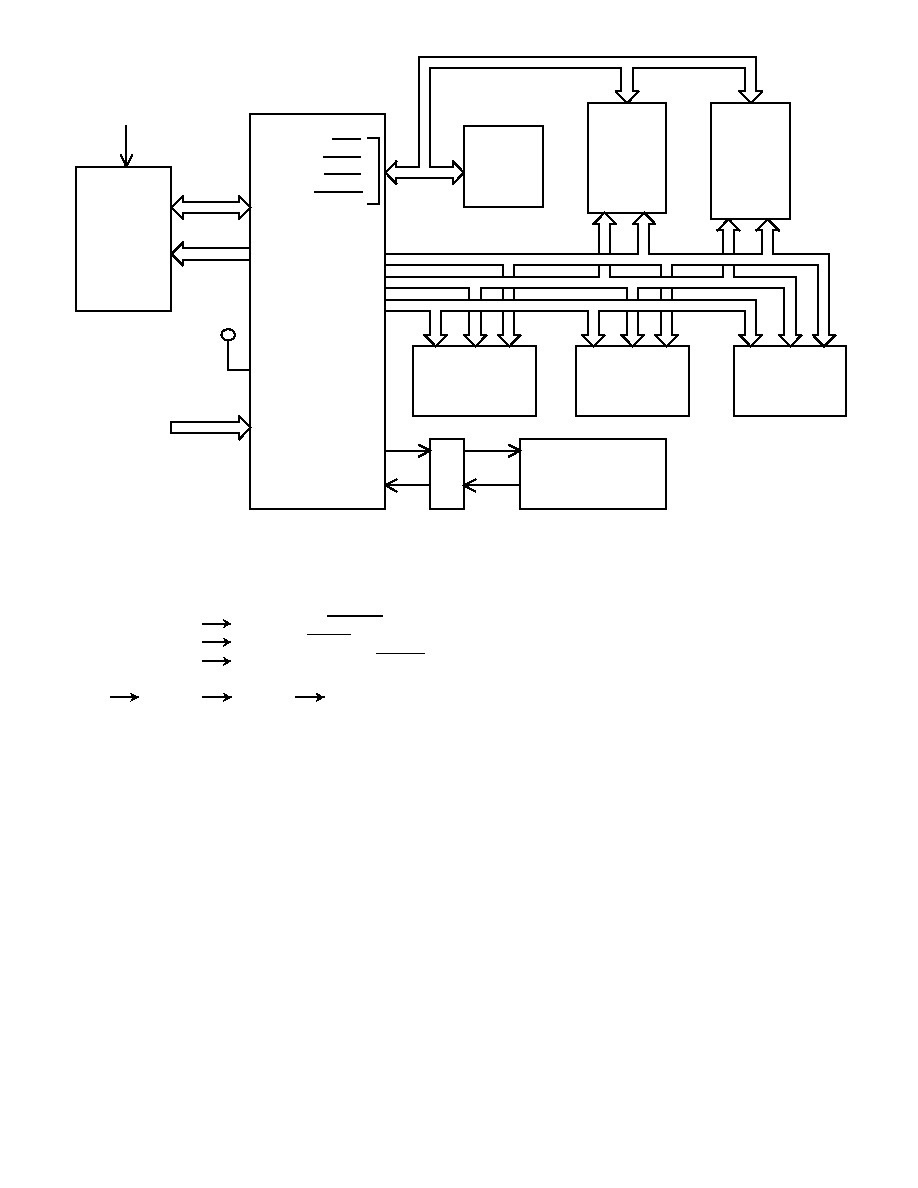- 您現(xiàn)在的位置:買賣IC網(wǎng) > PDF目錄293971 > 5962R0150202VYX 16-BIT, 16 MHz, RISC PROCESSOR, QFP132 PDF資料下載
參數(shù)資料
| 型號: | 5962R0150202VYX |
| 元件分類: | 微控制器/微處理器 |
| 英文描述: | 16-BIT, 16 MHz, RISC PROCESSOR, QFP132 |
| 封裝: | FP-132 |
| 文件頁數(shù): | 5/53頁 |
| 文件大?。?/td> | 458K |
| 代理商: | 5962R0150202VYX |
第1頁第2頁第3頁第4頁當(dāng)前第5頁第6頁第7頁第8頁第9頁第10頁第11頁第12頁第13頁第14頁第15頁第16頁第17頁第18頁第19頁第20頁第21頁第22頁第23頁第24頁第25頁第26頁第27頁第28頁第29頁第30頁第31頁第32頁第33頁第34頁第35頁第36頁第37頁第38頁第39頁第40頁第41頁第42頁第43頁第44頁第45頁第46頁第47頁第48頁第49頁第50頁第51頁第52頁第53頁

13
The next three RISC address bits (RA16-RA18) are user-
definable discrete outputs. These outputs are defined as:
RA16/OD3
DMA enable (DMAEN)
RA17/OD2
power-up (GOOD)
RA18/OD1
start-up ROM enable (SUREN)
After reset these signals will be in the following states:
RA16
1, RA17
0, RA18
0.
When the UT1750AR operates in the MIL-STD-1750 mode, it
generates an address on the Operand address bus for the next
1750 instruction. If the UT1750AR has just been initialized or
has just been reset, the first memory location placed on the
Operand Address Bus is 0000H; this instruction is the first one
fetched from the 1750 memory. After this instruction is fetched
and entered into the UT1750AR, the UT1750AR uses the
opcode to “map” or point to a specific address in the RISC
memory. Since the RISC PROM programming provides 1750
emulation capability, this address in RISC memory contains a
specific RISC-coded macro allowing the UT1750AR to perform
the requisite 1750 function.
When the UT1750AR begins executing this RISC macro for
1750 emulation, the UT1750AR begins to operate as if it were
in the RISC mode (see the previous section on RISC mode of
operation). The processor cycles of all the RISC instructions
that make up the particular macro are executed as if the
UT1750AR were operating purely as a RISC.
During RISC macro execution for the MIL-STD-1750
instruction, the internal registers of the UT1750AR hold the
intermediate results from the execution of the RISC instructions.
When the macro is complete, the UT1750AR’s registers contain
the data the MIL-STD-1750A instruction requires.
If the UT1750AR receives an interrupt during RISC macro
execution, the RISC macro completes execution before the
UT1750AR recognizes the interrupt. This is similar to
completing a single 1750 instruction rather than allowing its
interruption. The only exception is with the multiple-word
MOV 1750 instruction. For this instruction, the UT1750AR
interrupts macro execution after transferring the current word.
After the RISC macro is complete, all the UT1750AR’s internal
registers, including the status registers and/or memory locations,
contain the results of the MIL-STD-1750A instruction that has
just completed execution. The UT1750AR now fetches the next
1750 instruction from Operand memory and the process repeats.
RISC
DATA
RISC
ADD
16
M1750
USER-
DEFINED
SYSTEM
INTERRUPTS
8
UART
I/F
X
C
V
R
1750
PROGRAM/DATA
MEMORY
I/O
DEVICE #1
I/O
DEVICE #2
BUS
ARBITER
DMA
DEVICE
#1
1553
I/F
DMA
DEVICE
#2
OP ADD
OP DATA
CONTROL
BRQ
BGNT
BUSY
BGACK
16
6
Figure 5. The UT1750AR in the MIL-STD-1750 Mode of Operation
4
UT1750AR
CONTAINS RISC MACROS TO
1750
MIL-STD-1750
EMULATE THE MIL-STD-1750A
ISA
EMULATION
ROM
(8K X 16)
+5V
PROGRAMMER’S
CONSOLE
相關(guān)PDF資料 |
PDF描述 |
|---|---|
| 5962R0722402VYC | SPECIALTY MICROPROCESSOR CIRCUIT, PQFP256 |
| 5962R8958702VXA | 5 V FIXED POSITIVE LDO REGULATOR, 1 V DROPOUT, CDSO16 |
| 5962R9215311VTA | 32K X 8 STANDARD SRAM, 55 ns, CDFP36 |
| 5962R9215311VTX | 32K X 8 STANDARD SRAM, 55 ns, CDFP36 |
| 5962G9215309VMX | 32K X 8 STANDARD SRAM, 55 ns, CDIP28 |
相關(guān)代理商/技術(shù)參數(shù) |
參數(shù)描述 |
|---|---|
| 5962R0253801VZA | 制造商:Analog Devices 功能描述:- Rail/Tube |
| 5962R0720802VXC | 制造商:Texas Instruments 功能描述:ADS5463 RHA QMLV DEVICE |
| 5962R0722601VZA | 制造商:Texas Instruments 功能描述:D/A CONVERTER, 12-BIT - Trays |
| 5962R0722701VZA | 功能描述:模數(shù)轉(zhuǎn)換器 - ADC 8-Ch 50 kSPS-1 MSPS RoHS:否 制造商:Texas Instruments 通道數(shù)量:2 結(jié)構(gòu):Sigma-Delta 轉(zhuǎn)換速率:125 SPs to 8 KSPs 分辨率:24 bit 輸入類型:Differential 信噪比:107 dB 接口類型:SPI 工作電源電壓:1.7 V to 3.6 V, 2.7 V to 5.25 V 最大工作溫度:+ 85 C 安裝風(fēng)格:SMD/SMT 封裝 / 箱體:VQFN-32 |
| 5962R0722902VXA | 功能描述:低壓差穩(wěn)壓器 - LDO 3-Terminal Adj Reg RoHS:否 制造商:Texas Instruments 最大輸入電壓:36 V 輸出電壓:1.4 V to 20.5 V 回動(dòng)電壓(最大值):307 mV 輸出電流:1 A 負(fù)載調(diào)節(jié):0.3 % 輸出端數(shù)量: 輸出類型:Fixed 最大工作溫度:+ 125 C 安裝風(fēng)格:SMD/SMT 封裝 / 箱體:VQFN-20 |
發(fā)布緊急采購,3分鐘左右您將得到回復(fù)。